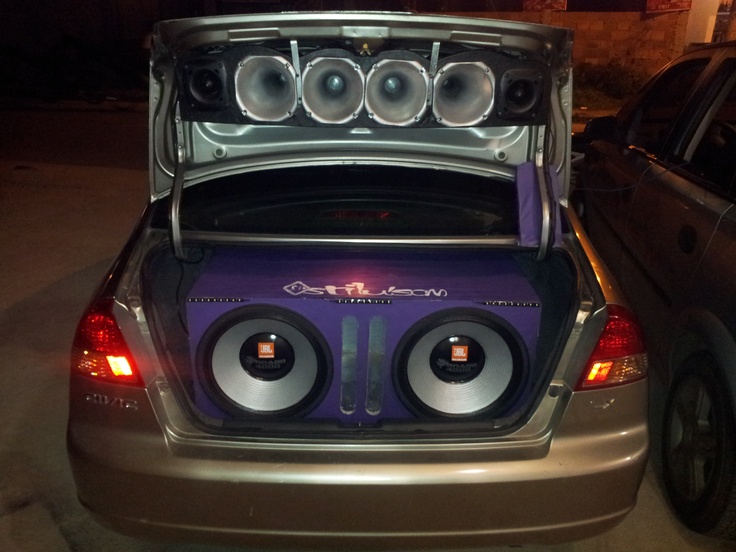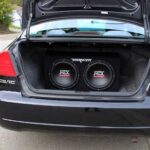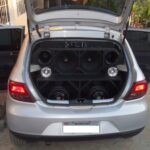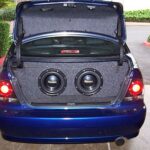What is the Best Position for a Subwoofer in a Car? (h1)
The best position for a subwoofer in a car is typically in the trunk or rear cargo area. Placing the subwoofer here allows for optimal sound distribution throughout the vehicle, resulting in a more immersive audio experience.
(This Portion is for Feature Snippet)
With the subwoofer located in the trunk, it can utilize the enclosed space to enhance bass response and produce richer low-frequency sounds. This position also helps to prevent any unwanted vibrations or rattling noises that might occur if the subwoofer were placed elsewhere in the car.
Overall, positioning the subwoofer in the trunk or rear cargo area is the ideal choice for achieving the best audio performance in a car.
Factors To Consider (h2)
When considering the best position for a subwoofer in a car, several factors should be taken into account to achieve optimal sound quality. From the acoustics of the car interior to the various placement options, making an informed decision is crucial for an enhanced audio experience.
Acoustics Of the Car Interior (h3)
Understanding the acoustics of the car interior is essential when determining the best subwoofer position. Factors like the size and shape of the vehicle, as well as the material used for the interior, can significantly impact sound quality. Additionally, the placement of other audio components, such as speakers, can affect the overall acoustics within the car.
When it comes to placing a subwoofer in a car, there are several options that can be considered. These commonly include placing the subwoofer in the trunk, under a seat, or within a custom enclosure. Each option comes with its own set of considerations, including available space, ease of installation, and impact on sound distribution.
Placement Options (h2)
When it comes to installing a subwoofer in a car, the placement of the subwoofer can greatly impact the overall sound quality. Let’s explore the various placement options to help you find the best position for a subwoofer in your car.
Placing a subwoofer in the trunk is a common option for car audio enthusiasts. The large space of the trunk allows for bigger subwoofers and provides the opportunity to create custom enclosures to optimize sound. However, in some cases, the sound waves may face obstructions from the rear seats, affecting the overall sound quality.
Utilizing the space under the seat for subwoofer placement can be a space-saving and convenient option. Installing a subwoofer under the seat can help save trunk space and still deliver powerful bass. However, the limited space under the seat might restrict the size of the subwoofer and impact the bass output.
Custom enclosures offer the flexibility to create a designated space for the subwoofer, optimizing its performance. Building a custom enclosure allows for fine-tuning the sound and minimizing any interference from other components in the car. By customizing the enclosure, you can tailor the subwoofer’s position to maximize sound quality.
Trunk Placement (h2)
Placing a subwoofer in the trunk of your car can provide an effective and convenient solution for enhancing your audio experience on the go. This positioning option allows you to maximize the available space and create a powerful bass response. However, trunk placement also comes with some drawbacks to consider. In this section, we will explore the pros and cons of placing a subwoofer in the trunk.
Pros Of Trunk Placement (h3)
Trunk placement offers several advantages when it comes to installing a subwoofer in your car:
- Ample Space: The trunk provides a generous amount of space compared to other areas in the car. This allows you to use larger and more powerful subwoofers, resulting in a deeper and richer bass.
- Enhanced Bass Response: Placing the subwoofer in the trunk creates a sealed chamber effect, enabling the bass to resonate throughout the entire car. This produces a more immersive and impactful audio experience.
- Protection: The trunk offers a secure and protected environment for your subwoofer. It minimizes the risk of damage or theft, keeping your investment safe and ensuring a longer lifespan for your sound system.
Cons Of Trunk Placement (h3)
While trunk placement provides numerous benefits, there are a few drawbacks to be aware of:
- Reduced Trunk Space: Placing a subwoofer in the trunk can take up a significant amount of space, limiting storage capacity for other belongings. This may impact the practicality of using the trunk for large items or luggage.
- Weight Distribution: The weight of the subwoofer in the trunk can affect the balance and handling of the car. It is important to ensure that the weight distribution remains even to maintain safe driving conditions.
- Rearview Visibility: Placing the subwoofer in the trunk may obstruct your rearview visibility to some extent. This can be a concern for safety, especially when maneuvering or parking the vehicle.
Under-seat Placement (h2)
One of the popular positions for placing a subwoofer in a car is under the seat. Let’s explore the pros and cons of this placement:
Pros Of Under-seat Placement (h3)
- Space-saving option for smaller cars
- Convenient installation location
- Helps to maintain a sleek and uncluttered interior
Cons Of Under-seat Placement (h3)
- Limited bass response compared to trunk placement
- Vibration may transfer to the seat
- Performance may be affected by seat adjustments
Custom Enclosures (h2)
Custom enclosures can significantly impact the performance of a subwoofer in a car. These enclosures are specially designed to optimize the sound produced by the subwoofer, ensuring that the bass is deep, precise, and impactful. By understanding the benefits of custom enclosures and the different types available, car audio enthusiasts can make informed decisions regarding the best position for their subwoofer.
Benefits Of Custom Enclosures (h3)
Custom enclosures offer several advantages when it comes to housing a subwoofer in a car. Most notably, these enclosures are tailored to the specifications of the subwoofer, ensuring optimal performance. Additionally, they can enhance the overall bass response and reduce distortion, providing a more immersive audio experience for car occupants. Moreover, custom enclosures also help protect the subwoofer from damage and improve its longevity.
Types Of Custom Enclosures (h3)
There are various types of custom enclosures available, each catering to different sound preferences and space limitations within a car. These include sealed enclosures, ported enclosures, and bandpass enclosures. Sealed enclosures are known for delivering accurate and tight bass, while ported enclosures are favored for producing louder and deeper bass. On the other hand, bandpass enclosures offer a combination of the benefits of sealed and ported enclosures, making them suitable for certain audio setups.
Optimizing Sound Quality (h2)
When it comes to enjoying optimal sound quality in your car, the positioning of the subwoofer is crucial. Optimizing sound quality in your car is not only about the speakers and the head unit, but also about the placement of the subwoofer. By strategically placing the subwoofer, you can achieve a balanced and immersive audio experience. Let’s explore the best positioning for a subwoofer in a car with a focus on maximizing sound quality.
Minimizing Distortion (h3)
To minimize distortion, place the subwoofer away from any metal components in the car such as the chassis or suspension. Additionally, ensuring that the subwoofer is securely mounted to reduce vibrations can also help in minimizing distortion. Positioning the subwoofer in a well-ventilated area can prevent overheating, which can also cause distortion.
Maximizing Bass Impact (h3)
Strategically placing the subwoofer in the trunk can help in maximizing bass impact. Position the subwoofer facing towards the rear of the vehicle to effectively utilize the acoustics of the car’s interior. Additionally, ensuring that the subwoofer is not obstructed by any objects or loose items in the trunk can contribute to maximizing bass impact.
Installation Tips (h2)
When it comes to getting the best performance out of your car audio system, the placement of the subwoofer is a crucial factor. To ensure that you achieve optimal sound quality, careful consideration must be given to the installation of the subwoofer in your car. Below are some essential installation tips to help you achieve the best sound from your car’s subwoofer.
Ensuring Secure Mounting (h3)
When it comes to mounting the subwoofer in your car, it’s essential to ensure that it is securely positioned to prevent any movement or rattling while on the road. Use a mounting bracket or enclosure that is specifically designed for the size and weight of your subwoofer. It’s important to find a secure and stable location to mount the subwoofer in your car to avoid any potential damage or interference with other car components.
Managing Wiring (h3)
Properly managing the wiring for your subwoofer is crucial for both performance and safety. Ensure that all power and ground cables are securely connected to the appropriate terminals, and use wire loom or tubing to protect the cables from potential damage. Additionally, route the wiring away from any moving parts or heat sources to prevent potential hazards or interference with the vehicle’s operation.
Integration With Existing Audio System (h2)
When it comes to achieving the best audio experience in your car, integrating a subwoofer with your existing audio system is essential. Properly integrating a subwoofer ensures that it complements the sound produced by the other speakers, delivering a balanced and immersive audio experience.
Balancing Sound Levels (h3)
One crucial aspect of integrating a subwoofer with your existing audio system is balancing the sound levels. Ensure that the subwoofer doesn’t overpower the other speakers, while still delivering deep bass without distortion. This can be achieved by adjusting the gain and crossover settings on the subwoofer amplifier to blend seamlessly with the rest of the audio system. Balancing the sound levels ensures that each component works together harmoniously, providing a rich and accurate audio experience.
Avoiding Interference with Other Speakers (h3)
Another important consideration when integrating a subwoofer is avoiding interference with the other speakers. Position the subwoofer carefully to avoid canceling out or overshadowing the frequencies produced by the other speakers. This can be accomplished by strategically placing the subwoofer in a location that complements the existing speaker setup, such as in the trunk or rear of the vehicle. By doing so, you can create a cohesive audio environment without any conflicting frequencies.
When balancing sound levels, ensure the subwoofer doesn’t overpower the other speakers, while still delivering deep bass without distortion. This can be achieved by adjusting the gain and crossover settings on the subwoofer amplifier. Avoid interference with the other speakers by positioning the subwoofer carefully to avoid canceling out or overshadowing the frequencies produced by the other speakers. This can be accomplished by strategically placing the subwoofer in a location that complements the existing speaker setup, such as in the trunk or rear of the vehicle.
Adjusting Settings (h2)
Once you have determined the best position for your subwoofer in your car, it’s time to fine-tune the settings to optimize its performance. The two main settings you will need to adjust are the crossover frequency and the gain control.
Crossover Frequency (h3)
The crossover frequency setting determines which frequencies are sent to the subwoofer and which are sent to the other speakers in your car audio system. Typically, the best crossover frequency for a subwoofer in a car is around 80 Hz. This allows the subwoofer to handle the deep bass frequencies while the other speakers can focus on the midrange and high frequencies.
Gain Control (h3)
The gain control, also known as the volume control, regulates the output level of the subwoofer. It is important to set the gain control correctly to ensure the subwoofer is loud enough to be heard, but not overpowering and causing distortion. To adjust the gain control, play a song with a prominent bass line and gradually increase the volume until you hear distortion, then back it off slightly.
It’s worth noting that every car audio system is different, so you may need to experiment with the crossover frequency and gain control settings to find the perfect balance for your specific setup. Don’t be afraid to make small adjustments and test the sound quality until you achieve the desired results.
Professional Installation Vs. Diy (h2)
Considerations for Professional Installation: (h3)
- Expertise in optimizing subwoofer placement.
- Ensures correct wiring for optimal performance.
- Professional tuning for the best sound quality.
Benefits of DIY Installation: (h3)
- Cost-effective approach for budget-conscious individuals.
- Opportunity for hands-on learning and skill development.
- Flexibility to customize installation to personal preferences.
Maintenance And Care (h2)
Maintaining and caring for your car’s subwoofer is essential to ensure optimal performance and longevity. By regularly cleaning the subwoofer and checking its connections, you can enjoy a deeper and more impactful bass experience every time you hit the road.
Cleaning The Subwoofer (h3)
Regular cleaning of your car’s subwoofer is important to remove dust, dirt, and any other particles that may affect its sound quality. Here are simple steps to effectively clean your subwoofer:
- Start by disconnecting the power source and removing the subwoofer from its enclosure, if possible.
- Using a soft microfiber cloth or a brush, gently wipe down the exterior of the subwoofer to remove any loose dirt or dust.
- If there are any stubborn stains or grime, you can use a mild cleaning solution or a mixture of water and gentle soap. Dampen the cloth or sponge slightly and carefully clean the surface of the subwoofer. Avoid spraying any liquid directly onto the subwoofer.
- Once you’ve cleaned the subwoofer, use a dry cloth to wipe away any residual moisture.
- Ensure the subwoofer is completely dry before reconnecting it and placing it back in its enclosure.
Checking Connections (h3)
Regularly checking the connections of your car’s subwoofer is crucial to maintain a consistent and uninterrupted bass performance. Here’s how you can ensure all connections are secure:
- Start by inspecting the power and ground connections. Ensure that the power wire is connected securely to the positive battery terminal and that the ground wire is properly connected to a clean metal surface on the car’s body.
- Next, check the RCA or speaker wire connections that connect the subwoofer to the amplifier or head unit. Ensure that they are firmly connected and free from any loose connections or corrosion.
- If you notice any loose connections or signs of corrosion, clean the connectors using a contact cleaner or a mixture of isopropyl alcohol and distilled water.
- Once all the connections have been checked and cleaned, reconnect the subwoofer and test its performance to ensure everything is working correctly.
By regularly cleaning your subwoofer and checking its connections, you can enhance its lifespan and ensure that it continues to deliver powerful and immersive bass in your car. Take the time to maintain and care for your subwoofer, and you’ll be rewarded with an exceptional audio experience on the road.
FAQ
What Is the Best Setting for A Subwoofer in A Car? (h3)
The best setting for a subwoofer in a car depends on personal preference and the type of music you listen to. Experiment with different levels to find the balance between bass and clarity that suits your taste. It’s important to also consider the size and design of your car’s interior.
How Do I Get the Best Sound from My Car Subwoofer? (h3)
To get the best sound from your car subwoofer, make sure it’s properly installed. Adjust the settings, including level, phase, and crossover. Use high-quality audio files and consider damping materials to reduce vibration for optimal performance. Regular maintenance and inspections will keep it sounding great.
Final Thought (h2)
To achieve optimal sound quality in your car, the placement of the subwoofer plays a crucial role. By experimenting with different positions, such as under the seat or in the trunk, you can find the best spot that enhances bass response and minimizes distortion.
Remember to consider the size and design of your car, as well as your personal listening preferences. Finding the perfect position will greatly enhance your audio experience on the road.






